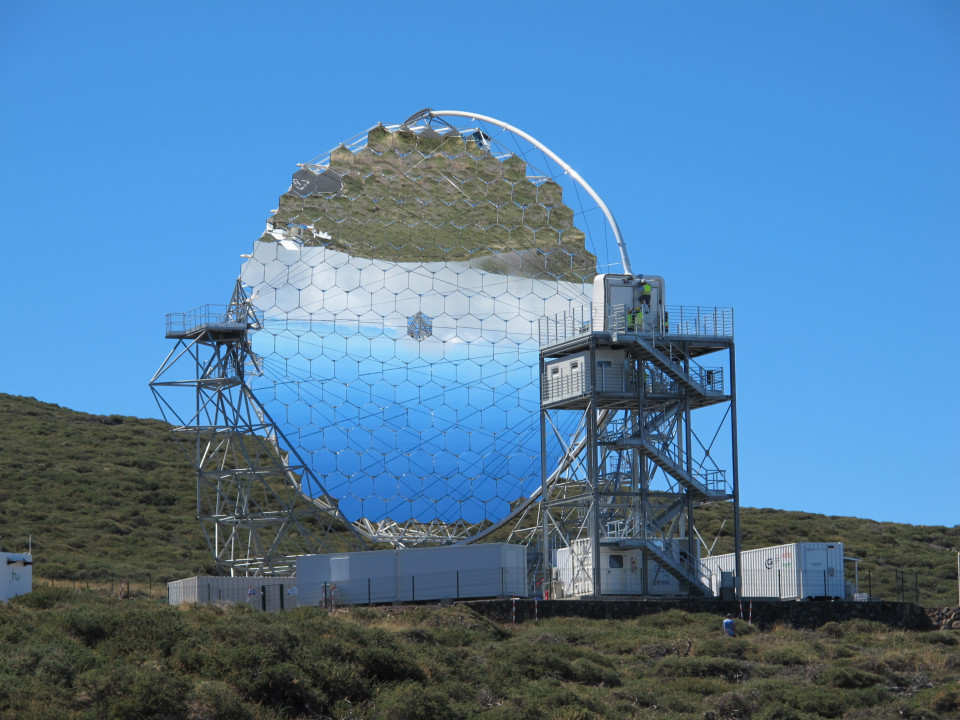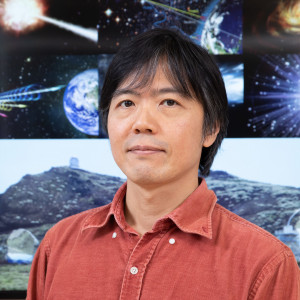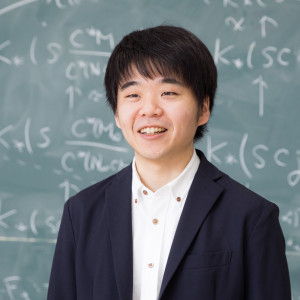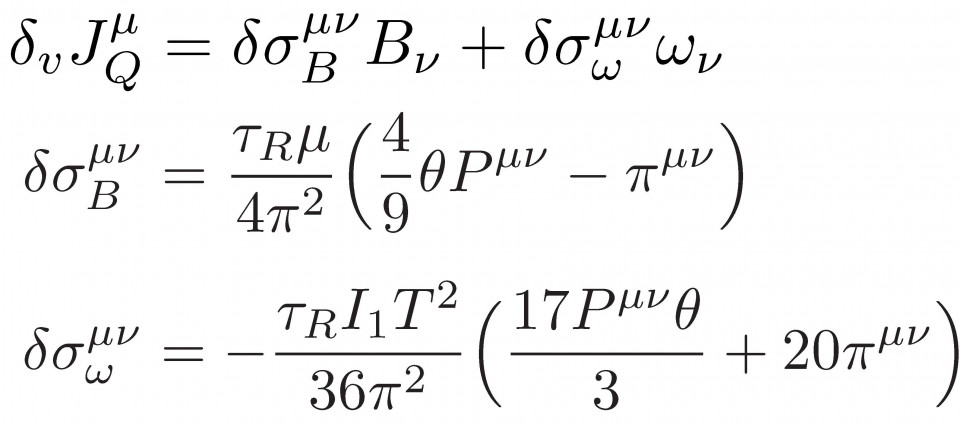Volume 26
Back to Newsletter List
Press Release
The First Telescope of a New Observatory for High-Energy Gamma-Ray Astronomy Makes its Debut
2018-10-16
Several iTHEMS members are actively involved in a brand-new, cutting edge astronomical project, called the Cherenkov Telescope Array (CTA). CTA will be the foremost global observatory for very high-energy gamma-ray astronomy over the next decade and beyond and will be the first ground-based gamma-ray astronomy observatory open to the world-wide astronomical and particle physics communities. The scientific potential of CTA is extremely broad: from understanding the role of relativistic cosmic particles to the search for dark matter. With its ability to cover an enormous range in photon energy from 20 GeV to 300 TeV, CTA will improve on all aspects of performance with respect to current instruments. From iTHEMS, Susumu Inoue and Yoshiyuki Inoue in particular have been actively contributing to the science case studies of multi-messenger transient phenomena and supermassive black holes as members of the CTA Consortium.
On Wednesday, 10 October 2018, more than 200 guests from around the world gathered on the northern array site of the CTA to celebrate the inauguration of the first prototype Large-Sized Telescope (LST). The telescope, named LST-1, is intended to become the first of four LSTs on the north site of the CTA Observatory, which is located on the existing site of the Instituto de Astrofisica de Canarias’ (IAC’s) Observatorio del Roque de los Muchachos located in the municipality of Villa de Garafia on the island of La Palma. The plan for the site also includes 15 Medium-Sized Telescopes (MSTs). The LSTs will expand the science reach to cosmological distances and fainter sources with soft energy spectra. Both the repositioning speed and the low energy threshold provided by the LSTs are critical for CTA studies of transient gamma-ray sources in our own Galaxy and for the study of active galactic nuclei and gamma-ray bursts at high redshift.
Upcoming Events
Seminar
Number Theory Seminar
Generalized Erdös and Obláth theorem for polynomial-factorial Diophantine equations
October 23 (Tue) 10:30 - 11:30, 2018
Wataru Takeda (Nagoya University)
Diophantine equations are equations where only integer solutions are accepted. There are many types of Diophantine equations and many results are known. Our Diophantine equation is of the form x^n+y^n=m!. Erdös and Obláth showed that the Diophantine equation x^2+y^2=m! has only two positive integer solutions (x,y,m)=(1,1,2),(12,24,6).
In this talk, the factorial function m! is replaced with a generalized factorial function Π(m) over number fields. Then whether there are infinitely many solutions or not depends on the number field. We give necessary and sufficient condition for existence of infinitely many solutions of x^2+y^2=Π(m). More generally, we introduce an observation for higher degree equation x^n+y^n=Π(m).
Venue: Large Meeting Room, 2F Welfare and Conference Building (Cafeteria), RIKEN
Event Official Language: English
Seminar
Number Theory Seminar
Relations between fractal dimensions and arithmetic progressions
October 23 (Tue) 11:35 - 12:35, 2018
Kota Saito (Nagoya University)
In this talk we give estimates for the dimensions of sets in real numbers which uniformly avoid finite arithmetic progressions. More precisely, we say that $F$ uniformly avoids arithmetic progressions of length $k\geq 3$ if there is an $\epsilon>0$ such that one cannot find an arithmetic progression of length $k$ and gap length $\Delta>0$ inside the $\epsilon\Delta$ neighbourhood of $F$. Our main result is an explicit upper bound for the Assouad (and thus Hausdorff) dimension of such sets in terms of $k$ and $\epsilon$. In the other direction, we give examples of sets which uniformly avoid arithmetic progressions of a given length. We also consider higher dimensional analogues of these problems, where arithmetic progressions are replaced with arithmetic patches lying in a hyperplane. As a consequence, we obtain a discretised version of a `reverse Kakeya problem': we show that if the dimension of a set in $\mathbb{R}^d$ is sufficiently large, then it closely approximates arithmetic progressions in every direction. The above is a joint work with Fraser and Yu. Finally we show that the converse of `reverse Kakeya problem' does not hold. This is a single-author work.
Venue: Large Meeting Room, 2F Welfare and Conference Building (Cafeteria), RIKEN
Event Official Language: English
Seminar
Assembly rules and a theory for invasion and extinction in minimal food webs
October 29 (Mon) 15:00 - 18:00, 2018
Namiko Mitarai (Associate Professor, Niels Bohr Institute, University of Copenhagen, Denmark)
We propose a theory of the evolution of a minimal food web by sequential invasion of new species [1]. Our theory is based on the standard generalized Lotka-Volterra equations, where basal species compete through resource depletion [2]. The considered food webs are “minimal”, as each species only feeds on a single resource, leading to a hierarchical, tree-like food web [1,3]. We prove that at each invasion step there is one uniquely determined outcome: either the invader peacefully coexists with the residents and resources are re-distributed; the invader is eliminated; or one or several of the resident species are removed in a uniquely defined extinction cascade.
At the end of either of these processes the resulting food web relaxes to a globally stable (and feasible) steady state. We break down the essence of our theory in the conceptual “invasion extinction model” (IEM), which allows us to analytically compute the persistence time and the extinction size distribution.
References
- Haerter, Jan O., Namiko Mitarai, and Kim Sneppen. "Theory of invasion extinction dynamics in minimal food webs." Physical Review E 97.2 (2018): 022404
- Haerter, Jan O., Namiko Mitarai, and Kim Sneppen. "Food web assembly rules for generalized Lotka-Volterra equations." PLoS computational biology 12.2 (2016): e1004727
- Haerter, Jan O., Namiko Mitarai, and Kim Sneppen. "Existence and construction of large stable food webs." Physical Review E 96.3 (2017): 032406
Venue: Seminar Room #160, 1F Main Research Building, RIKEN
Event Official Language: English
Seminar
Population genetics of duplicated genes
November 1 (Thu) 15:30 - 18:00, 2018
Hideki Innan (The Graduate University for Advanced Studies (SOKENDAI))
Venue: Seminar Room #160, 1F Main Research Building, RIKEN
Event Official Language: English
Workshop
Spintronics: from electrons to quarks (iTHEMS-CEMS Joint Meeting)
November 7 (Wed) 10:00 - 17:30, 2018
Program:
10:00-10:15 T. Hatsuda (RIKEN) “Opening”
10:15-10:45 S. Maekawa (RIKEN) “Introduction to Spintronics”.
10:45-11:45 M. Matsuo (KITS, Beijing) “Spintronics phenomena in non-inertial frames” (Review)
13:30-14:30 M. Hongo (Riken) “Introduction to chiral transport phenomena” (Review)
14:30-15:00 Y. Hidaka (RIKEN) “Non-Equilibrium Quantum Transport of Chiral Fluids”
15:30-16:00 Y. Tsutsumi (RIKEN) “Spin-Vorticity Coupling in Liquid He”.
16:00-16:30 T. Takiwaki (NAOJ) “Chiral magnetohydrodynamic turbulence in core-collapse supernovae”
16:30-17:30 Discussion (and Closing by T. Hatsuda)
Venue: Seminar Room #160, 1F Main Research Building, RIKEN
Event Official Language: Japanese
Math Lecture
Theory of Operator Algebras
Theory of Operator Algebras (5th)
November 8 (Thu) 13:30 - 15:00, 2018
Yosuke Kubota (Research Scientist, RIKEN Interdisciplinary Theoretical and Mathematical Sciences Program (iTHEMS))
Venue: Seminar Room #160, 1F Main Research Building, RIKEN
Event Official Language: Japanese
Seminar
The 28th QCD Club
November 9 (Fri) 15:00 - 17:00, 2018
Title: Application of a gradient flow method to thermodynamics of QCD with dynamical quarks
Language: Japanese or English
Event Official Language: English
Workshop
Supported by iTHEMS
Workshop on Recent Developments of Chiral Matter and Topology
December 6 (Thu) - 9 (Sun) 2018
The aim of this workshop is to gather researchers of high-energy and condensed-matter physics working on chiral Matter and Topology, to exchange ideas and establish collaborations to tackle unsolved issues and carry out future extensions. The workshop expects to welcome 40-60 participants who are interested in the aforementioned topics.
Organizers:
Tomoki Ozawa, Tetsuo Hatsuda (RIKEN iTHEMS)
Di-Lun Yang (RIKEN Nishina Center; YITP, Kyoto)
Chang-Tse Hsieh (Kavli IPMU / ISSP, the Univ. of Tokyo)
Jiunn-Wei Chen, Guang-Yu Guo (National Taiwan Univ.)
Hsiang-Nan Li (Academia Sinica)
Venue: National Taiwan University, Taipei, Taiwan
Event Official Language: English
Math Lecture
Theory of Operator Algebras
Theory of Operator Algebras (6th)
December 20 (Thu) 15:30 - 17:00, 2018
Yosuke Kubota (Research Scientist, RIKEN Interdisciplinary Theoretical and Mathematical Sciences Program (iTHEMS))
Title: An introduction to operator algebras
Abstract: Operators are linear maps from a (usually an infinite dimensional) linear space (most frequently the Hilbert space) to itself, which is like matrices of infinite degree. Operators form an algebra by obvious addition and multiplication. Operators appear in most of the fields in mathematics, in algebra, in geometry, in analysis, ... Some of the key words at the beginning of these lectures are "spectral theory" "operator algebras" "Tomita-Takesaki theory". These lectures are for non-professional people.
Venue: Seminar Room #160, 1F Main Research Building, RIKEN
Event Official Language: Japanese
Conference
Co-hosted by iTHEMS
The 7th International Symposium on Data Assimilation (ISDA2019)
January 21 (Mon) - 24 (Thu) 2019
The symposium will focus on the cross-cutting issues shared in broad applications of data assimilation from geoscience to various physical and biological sciences. In particular, the symposium will enhance discussions among researchers with various background on, for example, non-Gaussian and nonlinear data assimilation problems, Big Data Assimilation (BDA), high-performance computation (HPC), Uncertainty Quantification (UQ), advanced intelligence (AI) and machine learning, multi-scale and multi-component treatments, observational issues, and mathematical problems.
Abstract Submission Deadline: October 14, 2018 at 11:59 p.m. UTC
Registration Deadline: December 16, 2018 at 11:59 p.m. UTC
Submission/Registration Fee: Free
Venue: 6F auditorium, Computational Science Research Building, R-CCS, Kobe Campus, RIKEN
Event Official Language: English
Featured Paper of the Week
Non-equilibrium Chiral Magnetic/Vortical Effects in Viscous Fluids
2018-10-18
Chiral magnetic and vortical effects are novel effects in quantum fluids with chiral anomaly. We utilize the chiral kinetic theory in a relaxation-time approximation to investigate the nonlinear anomalous responses of chiral fluids with viscous effects. Unlike the cases in equilibrium, it is found that the chiral magnetic effect and chiral vortical effect are modified by the shear and bulk strengths. Particularly, the shear strength could result in charged Hall currents for chiral magnetic and chiral vortical effects, which propagate perpendicular to applied magnetic fields and vorticity. These quantum corrections stemming from side jumps and anomalies are dissipative and pertinent to interactions.
Reference:
Yoshimasa Hidaka, Di-Lun Yang
"Non-equilibrium Chiral Magnetic/Vortical Effects in Viscous Fluids"
Phys. Rev. D 98, 016012 (2018)
doi: 10.1103/PhysRevD.98.016012
arXiv: 1801.08253
If you would like to cancel your subscription or change your email address,
please let us know via our contact form.
Copyright © iTHEMS, RIKEN. All rights reserved.







